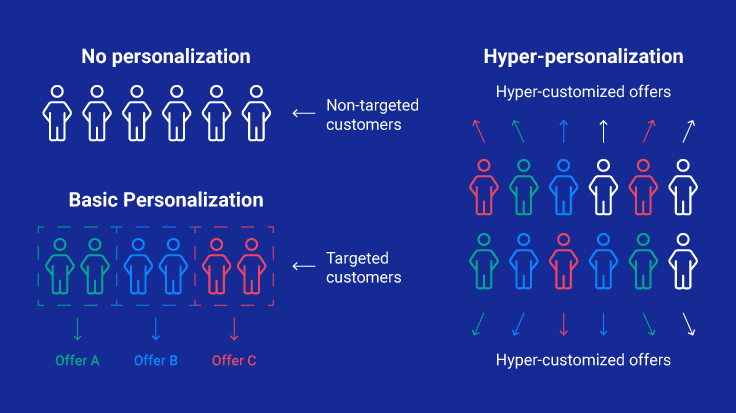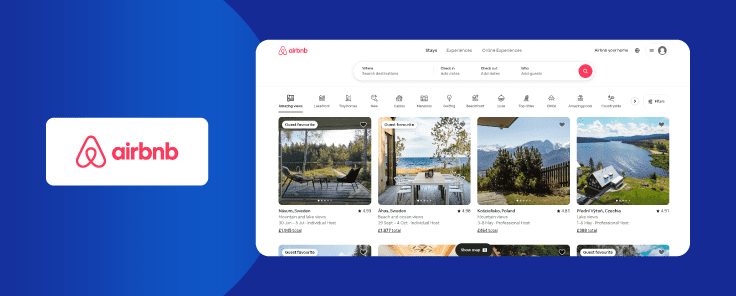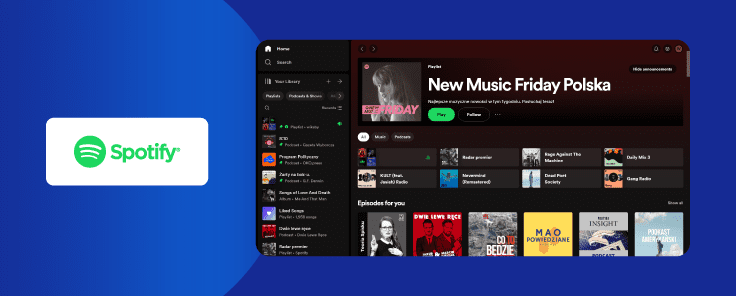The Power of Hyper-Personalization: How AI Elevates Customer Experience
- Published
- 7 min reading
Building customer loyalty nowadays requires companies to be much more thoughtful than they used to be. Customers want to feel that they are not just a means of generating profit for the brand. Instead, they want to feel like valuable partners who are approached in an individual way. The answer to their needs is hyper-personalization, which is becoming an increasingly popular standard across industries. What is it, what are its benefits, and how can it be effectively implemented?
What Is Hyper-Personalization?
Hyper-personalization is a marketing strategy that uses artificial intelligence and machine learning to create personalized customer experiences that are unique to each recipient.
The goal of hyper-personalization is also to increase conversion rates and customer lifetime value. By collecting data, analyzing consumer behavior, and refining content personalization, hyper-personalization can attract customers, reduce retention costs, and increase profits.
Effectively implemented, hyper-personalization can deliver a return on marketing spend and increase revenue by 10% or more. In addition, up to 80% of customers are more likely to buy from a company that offers a personalized customer experience.
By tailoring content and offers to individual customer preferences, hyper-personalization helps build lasting relationships and increases audience engagement, resulting in higher conversion rates and increased customer value. It is well worth implementing in most relevant channels of your business, as up to 90% of customers find personalization appealing.
What is the difference between hyper-personalization and traditional personalization?
Hyper-personalization is an evolution of traditional personalization, helping to take advantage of areas where traditional methods have reached limitations and barriers.
Scale of personalization
In traditional personalization, content customization is relatively basic and limited in its scope, usually relying on basic customer information such as name or last purchase. Hyper-personalization offers greater flexibility and the ability to make non-standard adjustments.
By using predictive analytics and leveraging advanced AI tools and data analytics, it allows creation of much more precise and comprehensive experiences, even taking into account subtle preferences and individual customer behaviors.
Responsiveness and immediacy
Traditional personalization can be delayed and limited by the time it takes to customize content. With hyper-personalization, algorithms operate in real time, analyzing current customer behavior and instantly adjusting content or offers in response to that behavior.
Conversion efficiency
Hyper-personalization often results in higher conversion rates than traditional personalization because offers and content are more precisely tailored to customers' needs and preferences. This can lead to increased customer engagement, loyalty, and revenue.

How can hyper-personalization work?
Hyper-personalized marketing utilizes advanced algorithms and real-time data to deliver personalized experiences to customers at various stages of their purchasing journey.
- Advertising: By using data about customer behavior and preferences, hyper-personalized ads can deliver content that is precisely tailored to each customer's individual interests and needs.
- Landing pages: With hyper-personalization, each customer sees the content, products and offers that are most interesting and relevant to them.
- Hyper-personalized communications: With AI, messages, videos or images in emails can be customized based on individual customer preferences and behaviors. As a result, each customer receives communications that are more relevant and engaging.
- Omnichannel customer service: An omnichannel personalization leveraging AI ensures that customers interact with a consistent brand presence across multiple channels by integrating customer information across channels, providing a better user experience.
- Recommendation engines: they can provide customers with personalized product suggestions that are most interesting and relevant to them, increasing the likelihood of purchase.
- Pre-populated applications: Applications and forms are pre-filled with customer data, making the company's services faster and more convenient to use, increasing customer satisfaction.
- Dynamic pricing and promotions: Prices and offers are dynamically adjusted by AI algorithms based on individual customer preferences and behaviors.
- Real-time product alerts: Customers receive real-time notifications based on their individual preferences and behaviors, increasing the likelihood of purchasing products that are relevant to them.
- Loyalty and re-engagement: Through carefully designed communications and actions, re-engagement can help increase customer engagement and loyalty, and recapture potential lost business opportunities.
Benefits and Challenges of hyper-personalization
With hyper-personalization, marketing can be much more effective, resulting in increased customer engagement, revenue growth, and the creation of lasting customer relationships. When done well, it can significantly increase impulse purchases, which are tailored to the point that 85% of customers are satisfied, and only 5% of all shoppers return their purchase.
In addition, hyper-personalization enables companies to avoid wasting resources on ineffective marketing efforts and prevent losses associated with customer churn due to improperly personalized experiences.
However, there are challenges associated with hyper-personalization. One is proper data management and compliance with privacy regulations. It's also important to use this tool wisely, as customers can feel overwhelmed by the endless possibilities of personalization. They may even feel tracked and hunted, especially if the algorithms are too effective at predicting their behavior.
It's also worth noting that advanced personalization cannot happen without high-quality content, which must be developed and managed by specialists. Such personalized content cannot be generated and managed solely by AI, as recipients will perceive it as unnatural and unfriendly.
In conclusion, while hyper-personalization offers numerous benefits, it's critical for companies to address the challenges and use it responsibly to effectively improve customer experiences.
AI driven future of hyper-personalization
Artificial intelligence plays a critical role in the future of hyper-personalization, enabling more advanced and effective personalization strategies. By leveraging advanced machine learning algorithms, AI allows companies to analyze vast amounts of data in real time and deliver personalized experiences at the highest level.
One of the key directions in the evolution of AI-based hyper-personalization is the growing importance of automating personalization processes.
Companies are increasingly relying on intelligent automation systems that can dynamically adjust customer experiences based on their behaviors and preferences.
In addition, advances in AI technology are enabling increasingly sophisticated data analysis, allowing companies to better understand customer needs and deliver even more personalized offers and communications.
Finally, AI has the potential to predictively analyze customer behavior based on patterns across a larger number of users and make personalized recommendations for relevant channels even before customers are aware of their own needs.
As a result, companies can provide customers with even more personalized and expectation-based experiences, beyond consumer expectations and resulting in greater customer loyalty and increased profits for companies.
Hyper-personalization examples in action
Services such as streaming platforms, retailers, travel companies, and public institutions are implementing hyper-personalization strategies. Here are a few examples:
Netflix
Netflix uses hyper-personalization to deliver individualized experiences to users when presenting search results. The platform matches different thumbnails of the same movie or TV show to each user's interests.

Airbnb
Airbnb allows users to discover local attractions tailored to their areas of interest. The app shows users attractions in their neighborhood or current location that match their past behavior and choices.

Spotify
Spotify gives us other examples of hyper-personalization in content delivery through features like Discover Weekly, which presents a specially curated playlist based on a user's previous selections. The app also allows users to purchase tickets to concerts and events they might be interested in.

Hyper-personalization across industries
Hyper-personalization is being used in a variety of industries to provide customers with better experiences. What exactly does its use involve?
- Finance - Hyper-personalization in finance enables a more customer-centric approach in an industry typically associated with cutting-edge technology and often lacking a "human touch".
The key premise of this strategy is to deliver personalized product designs, advice tailored to the actual needs of the customer, and communications that resonate with the customer. - Retail - In this industry, hyper-personalization is all about honesty and relevance. The goal for companies is not just to convince the customer to make a purchase. Instead, it's about building a relationship with them and offering them the products they really need.
- Public Sector - The goal of hyper-personalization in the public sector is to create a citizen-friendly environment by understanding their needs and providing them with the services they need at any given time.
- Healthcare - The overall goal of this sector is not only to provide healthcare when needed, but also to help maintain the overall health and well-being of citizens. To achieve this, hyper-personalization can be used, for example, to build relationships with patients and provide them with personalized lifestyle guidelines.
How to Use Hyper-Personalization to Increase Customer Loyalty
Hyper-personalization is a key strategy for companies looking to increase customer loyalty by delivering personalized experiences. 86% of automotive customers say they are more likely to use services or make purchases on a website or site that offers them a personalized experience.
However, the same group of customers admit that only 55% of websites offer a satisfactory level of personalization. There are several effective ways to use hyper-personalization to build customer loyalty.
The first step is to gather relevant customer data, such as their preferences, purchase history, or interactions with the brand. With this data, a company can better understand customer needs and expectations and tailor offers and communications accordingly.
It's worthwhile to use hyper-personalization to provide customers with personalized product and service recommendations based on their individual preferences and needs.
The next step is to personalize offers and rewards within loyalty programs and to use personalized communications with customers. This could include sending personalized emails, videos, or images. This allows the company to better engage customers and build stronger relationships with them.
Finally, it's critical to constantly monitor the effectiveness of efforts and adjust strategies based on collected data and customer feedback. In this way, the company can not only increase customer loyalty, and customer retention, but also build long-term relationships.
The future of hyper-personalized marketing
Hyper-personalization is the future of marketing, helping to build and maintain customer relationships, loyalty and engagement. By leveraging the latest technologies, it can help not only to deliver personalized offers to customers, but also to deliver the most relevant marketing message that will elicit positive responses and strengthen their relationship with the brand.
However, new personalization trends will not remove the human element from the process. High-quality and engaging content, as well as common human intuition, will still be needed. They will help ensure that users do not feel overwhelmed by the possibilities of hyper-personalization.






